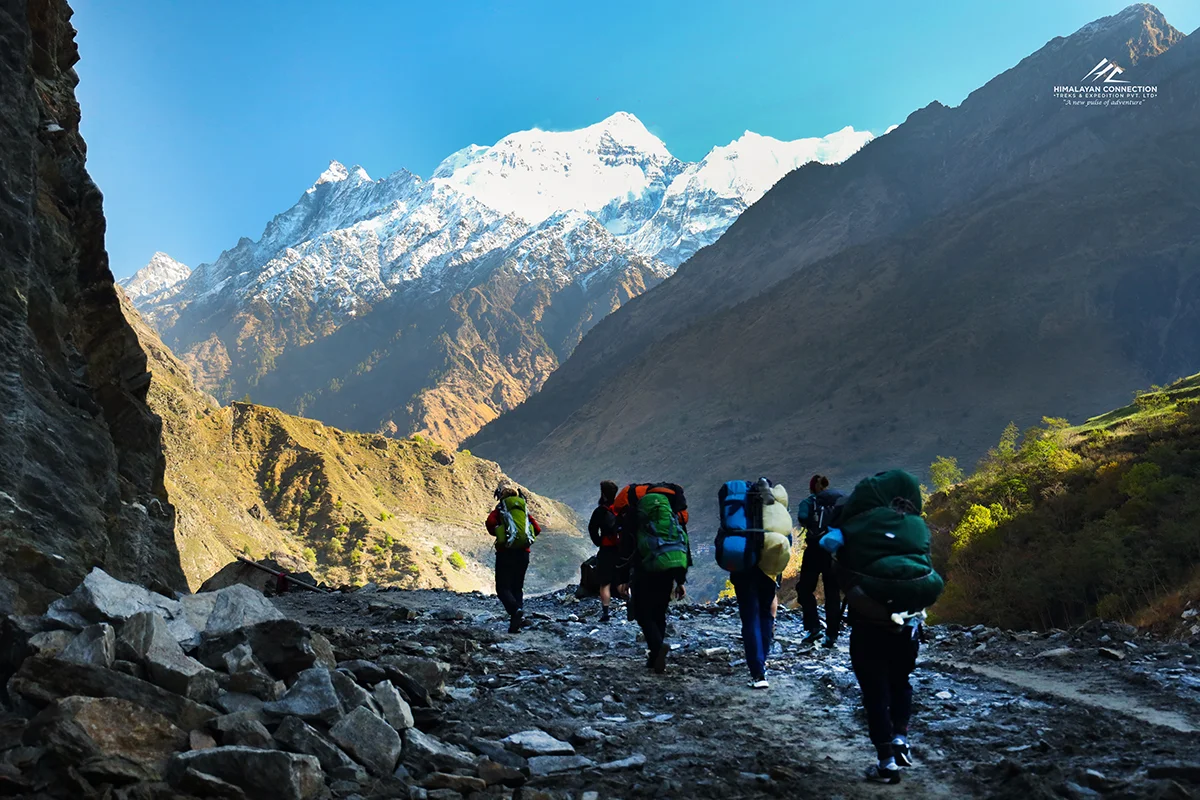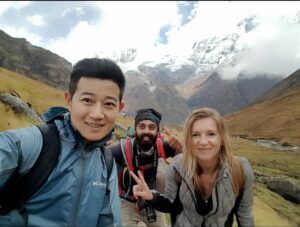

The Tsum Valley trek enables you to set off on an adventure to the serene and gorgeous Tsum Valley, a hidden jewel of the Himalayas, and enter a peaceful serene environment of your own!
The Tsum Valley trek enables you to set off on an adventure to the serene and gorgeous Tsum Valley, a hidden jewel of the Himalayas, and enter a peaceful serene environment of your own!
Tsum Valley Trek, the secluded and culturally significant Tsum Valley Trek is a trekking route found in Nepal's Gorkha province. This walk offers breathtaking vistas of the Himalayan Mountains as well as a chance to learn more about the traditional Tibetan Buddhist culture. The walk through beautiful forests, rugged terrain, and traditional hamlets as it follows the Budhi Gandaki River.
The Tsum Valley trek offers a unique and cultural experience for travelers. It is located in the remote and beautiful Tsum Valley, nestled in the foothills of the Ganesh and Boudha Himal mountain ranges. The valley is rich in cultural heritage and offers a glimpse into the traditional way of life in the remote Himalayan region.
The Tsum Valley trek's visit to various historic monasteries and gumbas (Buddhist shrines) in the area is one of its main features. The monasteries Rachen Gumba, Mu Gumba, and Sama Gumba are a few notes. These monasteries, which the locals revere as holy, are thought to have been founded by Guru Rinpoche, also known as Padmasambhava. The Tsum Valley is considered to be one of the holiest regions in Nepal and is also known for its rich cultural heritage.
The trek provides opportunities to experience the distinct culture and way of life of the Tsum people in addition to the monasteries. The Tsum people have managed to maintain their traditional way of life despite industrialization. They have their own unique language and customs. Traditional hospitality and regional cuisine are available to visitors in the communities of the area.
The largest and most significant monastery in the valley, Mu Gompa, is where the journey ends. Trekkers can take in expansive vistas of the Himalayan range from here, including the magnificent Ganesh Himal, Sringi Himal, and Baudha Himal peaks.
The Tsum Valley trek is a moderate to challenging trek that requires good physical fitness and acclimatization. The trek can be completed in about 10 to 14 days and is best done from August to November or March to June. During these months, the weather is stable, and the trekking routes are clear of snow. The trail is well-maintained and well-marked, making navigation relatively straightforward.
You can also opt for the Manaslu Tsum Valley trek which offers a number of breathtaking vistas; thus it is absolutely worthwhile to make it all the way to the Manaslu Circuit.
In conclusion, the Tsum Valley trek is a unique and off-the-beaten-path trekking experience that combines stunning natural beauty with rich cultural heritage. If you're looking for an adventure that offers a unique blend of nature, culture, and spirituality, the Tsum Valley trek is definitely worth considering and it is a must-visit destination for anyone looking to experience the true essence of Nepal.
Trekkers can encounter a number of attractions on the Tsum Valley Trek in Nepal, a country with a diverse culture and beautiful natural surroundings. The following are a few of the Tsum Valley Trek's noteworthy highlights:
In conclusion, the Tsum Valley Trek offers a distinctive blend of cultural heritage, natural beauty, and physical hardship. It is a unique trekking experience. The Tsum Valley Trek is unquestionably worth taking into consideration for your upcoming adventure in Nepal, regardless of whether you are an experienced trekker or a novice.
The months of August through November or March through June are ideal for traveling to Nepal's Tsum Valley trek. It is simpler and more comfortable to complete the walk during these months since the weather is consistent, the skies are clear, and there is no snow on the trekking trails.
Trekking is best done during the warm, dry months of August through November. The Himalayan range and the surroundings are beautifully visible because of the often clear skies. The best season to go trekking is from March to June since the weather is moderate and there is no snow on the trekking trails. However, the typically gloomy sky can make it difficult to see the Himalayan range.
It is crucial to remember that the Tsum Valley is situated in a rural area where the weather is unpredictable. Trekkers are urged to pack proper clothing and equipment for the trek and to be prepared for any weather situations. To conclude, the Tsum Valley Trek is best experienced between August and November or March and June when the weather is stable, the skies are clear, and there is no snow on the trekking trails.
It takes good physical condition and acclimation to complete the moderate to difficult Tsum Valley Trek in Nepal. Several steep ascents and descents, high-altitude passes, and walking over rocky, rough terrain are all part of the expedition. The trek's overall length is around 125 kilometers, and the peak elevation is attained at a height of about 5,000 meters. The trek is considered moderately difficult, but it is appropriate for seasoned trekkers searching for a physically hard and gratifying experience. The duration of the walk might range from 10 to 14 days, depending on the pace and plan of the trekker.
It is crucial to remember that the Tsum Valley's high altitude and remote location can present various health and safety dangers, including the possibility of altitude sickness, hypothermia, and other health risks. It is suggested that hikers are physically and mentally ready for the walk and take the essential steps to stay safe and healthy while trekking.
Therefore, the Tsum Valley trek is a moderate to difficult trek that necessitates good physical condition, acclimatization, and preparation. It is appropriate for seasoned hikers seeking a strenuous yet rewarding trip in a remote and culturally diverse area of Nepal.
The detailed itinerary of the Tsum Valley Trek is as follows:
Camp: Machha Khola
Altitude: 930m./3050ft.
Time: 8 – 9 hrs. drive
Meals: Breakfast, lunch, and dinner
Accommodation: Tea house
Camp: Jagat
Altitude: 1410m./4625ft
Time: 5 – 6 hrs walk
Meals: Breakfast, lunch, and dinner
Accommodation: Tea house
Camp: Lokpa ( Tsum Valley )
Altitude: 2240m./7347ft
Time: 5 – 6 hrs walk
Meals: Breakfast, lunch, and dinner
Accommodation: Tea house
Camp: Chumling (Tsum Valley)
Altitude: 3200m./10496ft
Time: 4 – 5 hrs walk
Meals: Breakfast, lunch, and dinner
Accommodation: Tea house
Camp: Chhekampar (Tsum Valley)
Altitude: 3030m./9938ft
Time: 5 – 6 hrs walk
Meals: Breakfast, lunch, and dinner
Accommodation: Tea house
Camp: Nile (Tsum Valley)
Altitude: 3360m./11021ft
Time: 5 – 6 hrs walk
Meals: Breakfast, lunch, and dinner
Accommodation: Tea house
Camp: Rachen Gumba (Tsum Valley)
Altitude: 3240m./10627ft
Time: 7 – 8 hrs walk
Meals: breakfast, lunch, and dinner
Accommodation: Tea house
scenic drive back to Kathmandu after finishing the off-the-beaten-path trek.
The Tsum Valley Trek is a trek in the remote Nepalese Himalayas that is rich in spirituality and culture.
Trekkers will pass through the lovely valleys of the Tsum region and be treated to breathtaking vistas of the mountains in the area, including the Ganesh Himal Range.
Trekkers can visit old monasteries and learn about the region's distinctive Tibetan-influenced culture as part of the walk, which also offers a distinctive cultural experience.
The Tsum Valley Trek is rated as a moderate to difficult trek. There are numerous days of trekking involved, some of which might be physically taxing. The walk is ideal for people with a good level of fitness and the willpower to finish it, though.
The Tsum Valley Trek is best enjoyed between March and May and September and November when the weather is clear and the surrounding mountains are at their most picturesque. But the walk can be done any time of year, and each season offers a different kind of adventure.
The following gear is advised for the Tsum Valley Trek: a good quality sleeping bag, headlamp, waterproof and insulated jacket and pants, warm layers, hat, gloves, a quality backpack, sturdy and comfortable walking boots, and sunblock and sunglasses.
The majority of meals are given by the teahouses along the way, and the menu on the Tsum Valley Trek consists of both native and Western cuisine.
Dal bhat (lentil soup and rice), momos (steamed dumplings), and other foods with Tibetan influences are traditional local fare. There are also Western alternatives including pasta, omelets, and sandwiches.
The Tsum Valley Trek does not strictly require a guide or porter, but they are highly advised.
The walk can be made more pleasurable and less physically taxing by hiring a porter to help carry equipment and supplies and a guide to share useful knowledge about the local culture and history.
With the travel from Kathmandu to the trek's starting point and back, the Tsum Valley Trek typically lasts 12 to 14 days. The precise length of the walk, however, may vary based on individual pace, the environment, and other elements.
The highest point on the Tsum Valley trek is Mu Gompa situated at an elevation of 3700m above the sea level.

I have had booked for ABC trip, and I got a wonderful experience journey on my first trekking trip. The staff of Himalayanconnections is professional, especially the guide's name is Sujan he is a nice funny and pro photographer. I promise myself when COVID-19 is gone; I will choose Himalayanconnections for my EBC trekking trip.